Temporary Dystopia: Shanghai in Absolute Lockdown to Contain the Omicron Variant
From end of March until end of May 2022, Shanghai experienced one of the world’s most brutal lockdowns during the COVID-19 pandemic, with serious consequences for daily life in this cosmopolitan city, and major impact on the global economy due to Shanghai’s world port. A year later, Shanghai’s urban economy is still struggling with consequences and many residents are suffering from the profound psychological impact of the unprecedented measures. As a resident of Shanghai since 2009, working for Tongji University’s College of Architecture and Urban Planning, I experienced the lockdown in full. In this article I will try to explain some of the consequences of this lockdown for the city, work, and daily life, from a limited perspective due to temporary restrictions on freedom of movement, limited information provided by authorities, and censorship of social media.
Following the outbreak of COVID-19 in Wuhan, an initial lockdown was imposed late January 2020 in Shanghai and most of the country. After this first relatively light lockdown, daily life quickly returned, thanks to strict closure measures at the national border – hardly any planes flew and on arrival you had to be in strict solitary confinement for up to four weeks, even young children were separated – and additional measures for people in daily life, aimed for zero-COVID. Continuous controls, including QR codes and infrared cameras to measure body-temperatures were tolerated by most people. As a result of these measures people in China experienced a fairly normal life compared to the rest of the world between Spring 2020 and Spring 2022. However, there was always a possibility of getting trapped during recurring controls. If there was an infection detected, the entire building or neighborhood (or even district) was locked several days or weeks. This went so far that any building could be immediately hermetically sealed, a residential block, an office, a school, or a mall, often with hundreds still inside, even if only one close contact 1 was suspected. People inside were given food and sleeping mats while obliged to stay inside for at least 48 hours, followed by additional home isolation. If any positive case was found, everyone was immediately quarantined in a fang cang (centralized isolation centers). In everyday life, people joked that you should always take a toothbrush and extra underwear with you when you go outside. Although the number of infections was minimal, this caused stress and uncertainty.
Sudden lockdown without warning
This relative freedom came to an abrupt halt for Shanghai. On 28 March 2022, the local government announced a citywide screening round, due to a rapid rising number of positive Omicron cases, with all citizens in home-isolation for four days and everyone being tested twice, starting with first the Pudong half east of the Huangpu River (where most cases were traced), and from 1 April the Puxi half of the city west of the river, where I live. Opposed to official public calming announcements that everyone could go outdoors again after these four days, this as “temporary” announced measure did not stop, since the detected number of infections continued rising steep. On 1 April the Pudong half didn’t reopen, which meant that the entire city was hermetically locked, a situation that continued until the end of May. In fact, many of my students who live on campus have been in isolation for three months and in some individual cases much longer.
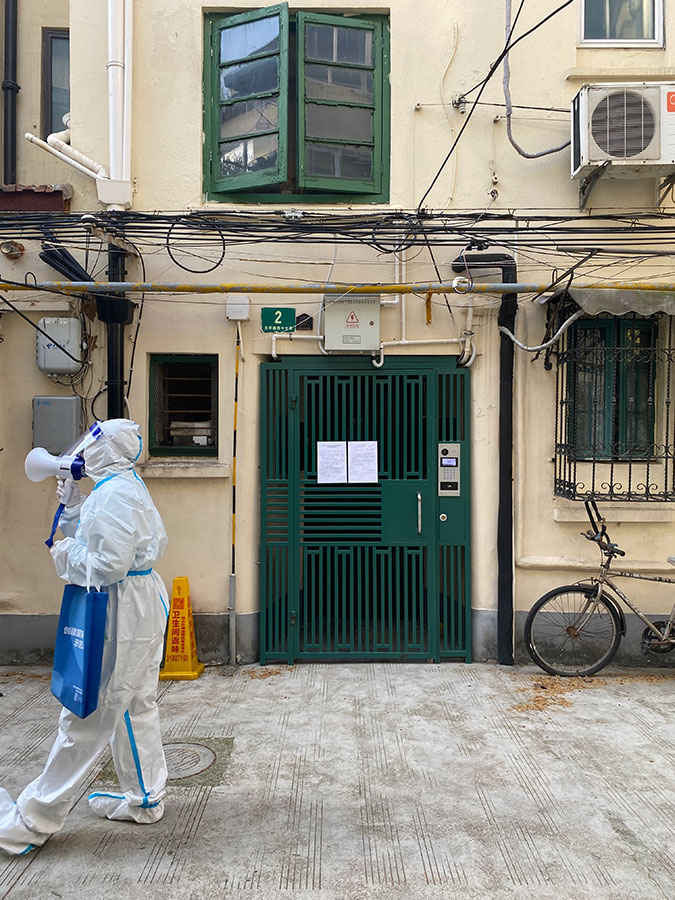
Fig. 2: Volunteer calling residents by name for PCR-test. (Photo by the author, 2022)
In fact, most universities and schools went into a lockdown earlier than the rest of the city. Early March 2022, my university went completely online because our campus, including many students and staff, got suddenly shut down after two students were detected as close contacts. Personally, I was lucky enough not to be on campus that day, otherwise I would have had to sleep there on the floor (mattresses and sleeping bags were provided on the second day). It gives me a feeling that schools are dealt with disproportionately. Recently (public) universities are increasingly monitored and there are even instruction meetings on political ideology.
As faculty member of a public university, between Spring 2020 and December 2022 I was required to take a PCR-test every time I crossed the municipal border. I needed to request digital travel permission from local authorities, and via cellphone data this was monitored. These rules were set by local authorities for all students and staff plus their relatives of public institutes. All my classes and workshops have been hybrid with screens and cameras in the classroom since Spring 2020, since half of my students were international students who no longer received visas.
During the lockdown there was no escape, a ride to the airport was almost impossible to arrange and easily cost many hundreds of euros per person due to a required driver with health certificate and license. This ride normally costs only one euro by metro, but all (public) transport stopped. In addition, there were no flights for two months, and afterwards only for exorbitantly high prices.
Further tightening of the lockdown
Following an inspection visit 2 by Vice-Premier Sun Chunlan on 2 April 2022 all local administrators of Shanghai were sidelined, and the national government took charge over the city, with very far-reaching consequences. Possibly as a reaction a prominent local public health administrator even took his own life that same day. The next day thousands of military doctors and caretakers were flown into the city, donned in anonymized hazmat suits, to provide the needed medical care, and to further roll out a system of fang cangs over the city. Countless people were forcedly relocated there by buses.
Shanghai’s suddenly implemented ruthless lockdown, overshadowed all previous lockdowns in China, in terms of social and economic impact. Other cities experienced (shorter) lockdowns at various times but received little international media attention (e.g., Yangzhou, Xi'an, and Shenzhen). Shanghai’s more than two months long lockdown had an impact not only on the city and its residents but far beyond. Although the port partly still functioned, worldwide logistics chains got seriously disrupted, amplified by interruptions of the global prominent financial sector in this metropolis. Shockingly, a very large part of the inhabitants of this fashionable ultramodern city even struggled with shortages of food and medicines, especially during the first three weeks, with dramatic consequences.
Unlike previous lockdowns, this time lockdown meant staying indoors 24/7, without exemption, including pets. People who tested positive plus all close contacts (even those who tested negative), which usually meant the whole building or even neighborhood, were unceremoniously relocated to fang cangs, were everyone still got infected quickly because very poor hygienic conditions. Images of deplorable situations in fang cangs circulated on social media before being quickly removed by authorities. Several people in my network have experienced staying there and confirmed the horrible conditions. I would estimate that at least 100,000 people have been residing in such centers for weeks, ranging from convention halls to repurposed office buildings and even swimming pools and containers (without windows). People in these isolation centers no longer count in the statistics as citizens: they are administratively “outside the society” in order to project an imaginary “zero-COVID” situation. As a result, it was possible for Shanghai to publicly announce on May 1 that there were no new infections, while in reality this was absolutely not the case.
Many personal dramas took place. In addition to the aforementioned shortages of food and medicines, there were multiple cases of food poisoning due to spoiled foodstuffs. In dormitories there have been cases of inaccessible collective showers and kitchens, and even camera installment for control. In response to this, there were local uprisings – beyond the so-called “pots and pans riot” that made it into the international media 3 . Sadly, in my neighborhood I heard of more than a few cases of suicide, and I’m afraid this happened citywide.
(Diary fragment 14 April 2022):
‘The food supply in my neighborhood is now reasonably in order, but that does not apply to large parts of the city elsewhere. Each neighborhood committee determines its own policy. Several cases of mismanagement or corruption are now known, for example situations where some of the food and medicines donated by the government did not end up with residents but were sold on to third parties. From what I've heard, I have the impression that this is more common in new towns, perhaps because neighborhood management there is often outsourced to commercial companies rather than based on chosen volunteers from the neighborhood.”
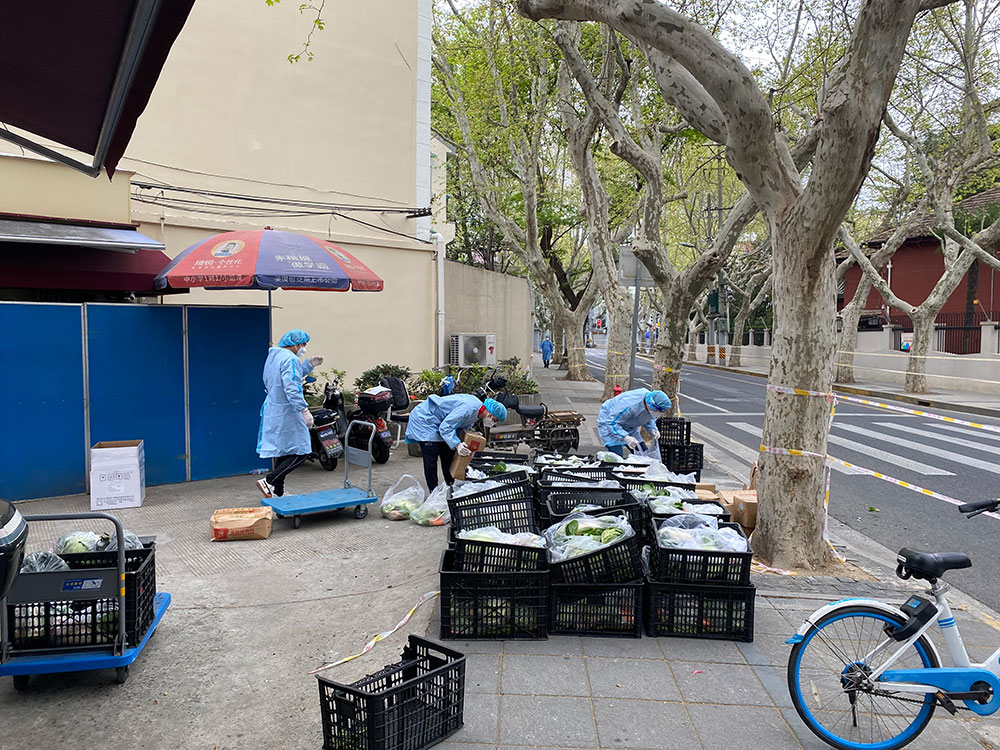
(Diary fragment 14 April 2022)
Fig. 3: Food distribution by volunteers. Notice the barrier tapes that are citywide along all sidewalks. (Photo by the author, 2022)
How could it get this far?
In all naivety, many people (including myself) thought that the virus would not strike on a large scale here. For that reason, many elderlies were not vaccinated in time. Although Omicron is considered as a less lethal variant, in densely populated China –with many enclosed spaces such as in elevators and subways – even with the most favorable calculations, the expected number of fatalities that could be prevented was according to some scientists up to 1.7 million people! Shanghai has the image of a modern city, but the national health care system is inadequate: in 2020, China had only 3.4 intensive care beds per 100,000 people, compared to an average of 12 in Europe (in Germany 29 beds). Thus, if the virus really gets free rein, it could have dramatic consequences.
In the second week of March 2022, the registration system that keeps track of PCR-test results collapsed due to overload. The construction of emergency hospitals and reception centers came to a halt because of insufficient staff. In Shanghai, there is a growing shortage of cheap labor since many migrant workers didn’t return to work due to strict zero-COVID policies.
(Diary fragment 21 April 2022):
“The street scene is somewhat ghostly, empty, with red barrier tapes everywhere. Barricades of concrete and metal divide the city into compartments. The (happy?) few who are still allowed outside are limited in action radius to a few hundred meters. Due to lack of materials some barricades are formed by stacked bicycles or wooden partitions. Most of the few people I meet outside are dressed in blue or white suits, unrecognizable and masked: guards, volunteers, and food couriers. Here and there a test street is open. There are also occasional coaches in which local residents are taken away to centralized isolation centers (the feared 方舱医院 or fang cang.”
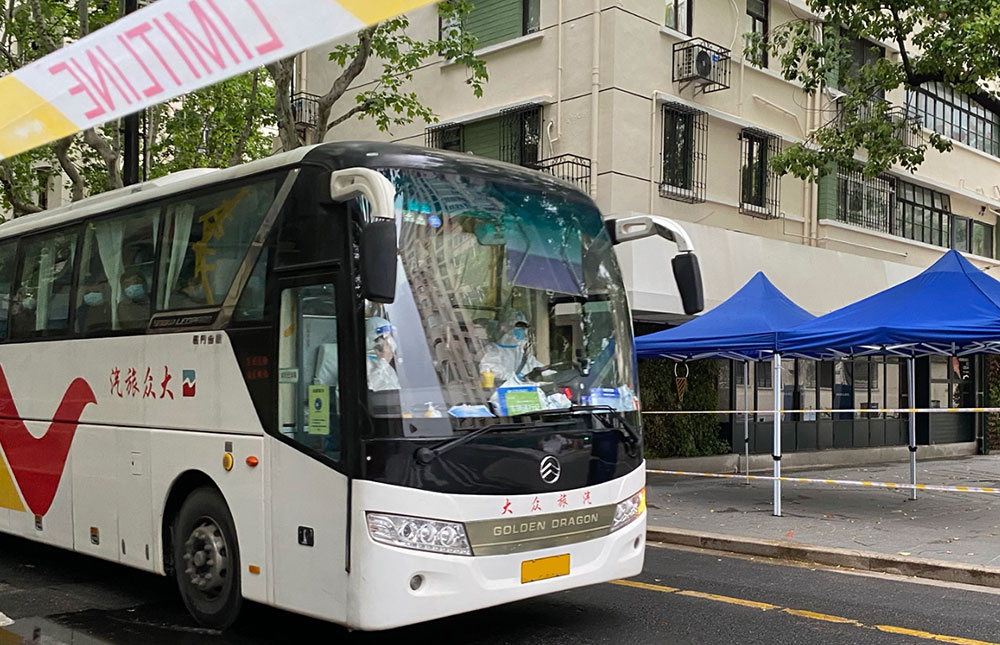
(Diary fragment 21 April 2022)
Fig. 4: Bus with residents on their way to a fang cang. (Photo by the author, 2022)
City under total control
China's urban planning system is based on compartmentalization in neighborhood units 4 . In fact, these are lockable compounds. This system largely contributed to the swift containment of the first variants of the coronavirus: a citywide lockdown could be implemented within hours. This compartmentalization makes clear that the whole society at any moment can transform into an absolutely controlled – dystopian – state in the blink of an eye. Only a few hours passed between the announcement of the closure of the Pudong half and the actual closure on 28 March 2022, causing the other half of the city to hoard four days' worth of food. Through supervision by neighborhood committees and a system of cameras – often with face-recognition – and other digital means, the city turned into a ghost town. Neighborhood committees with volunteers under government supervision – all in hazmat suits – were made responsible for distribution of food and medicines, and coordination of PCR-test rounds.
Luckily, after the 2020 lockdown I moved into a smaller neighborhood with only 25 households. Most neighborhood units include hundreds of households, often more than a thousand. If one person in any neighborhood unit was identified as close contact, this entire neighborhood got fully locked for at least two weeks or deported to a fang cang in case of any positive test. In my neighborhood we were locked indoors between April 1-14. During this period, no one was allowed to go outside 24/7. Every three days we were called at random times – sometimes even at night – to be escorted in small groups to a test center down the road for a PCR test. After 18 April I was told that I could walk outside the gate, though within the limits of my street, for one hour a day. Later, during May I found a way to extend my walking radius a little further outside. Compared to most other people in town this was a privilege, I think less than one percent of all neighborhoods were semi-open at that time. Hence, I was able to take many photos.
(Diary fragment 21 May 2022):
“Although officially more and more people are allowed to go outside, people prefer to stay inside because everything is closed. Even squares and parks have been cordoned off. You also run the risk of catching COVID and thereby causing total neighborhood confinement, which your neighbors will not appreciate. After an hour of walking, I am very happy back home, because outside is too spooky. It looks like a movie set from a flopped B-movie, the type I'd rather not watch. A friend told me that 28 Days Later by director Danny Boyle comes close.”
The lockdown ended officially on June 1. The old regime of local mini-lockdowns returned with – more frequent – sudden closures of neighborhoods, and even trains, and especially universities. This was often applied arbitrarily, with – in my opinion – possibly different motivations, especially when involving universities or old neighborhoods that are on a demolition list.
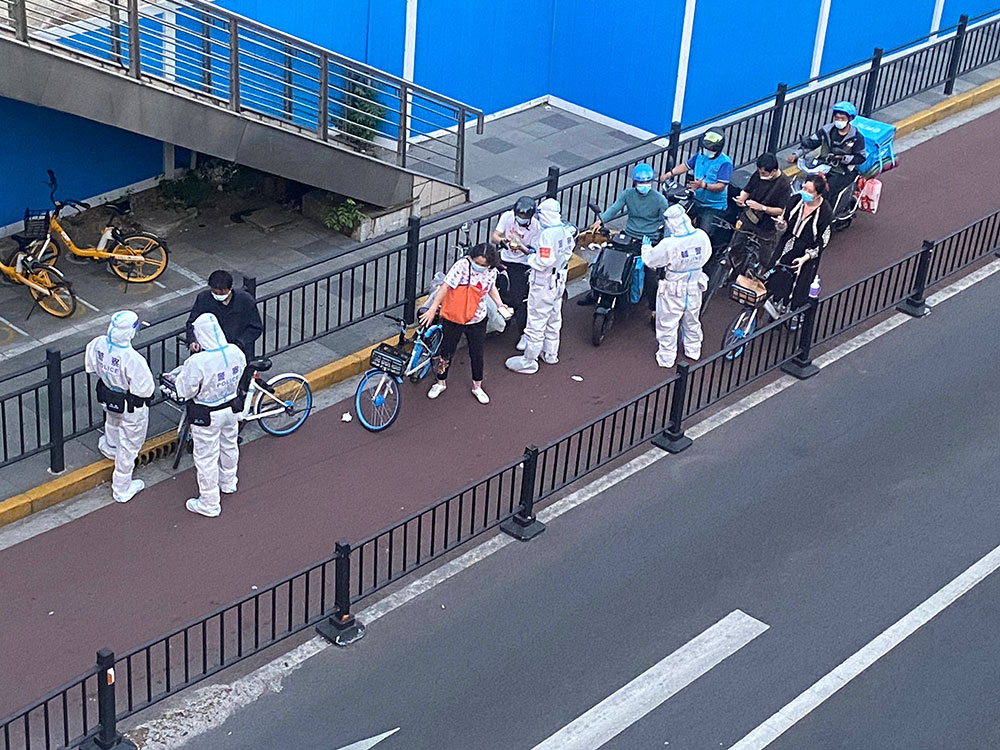
(Diary fragment 21 May 2022)
Fig. 5: Checkpoint on the border between two zones. (Photo by the author, 2022)
After the lockdown ended a network of 9000 test booths was rolled out, requiring residents to test every 72 or 48 hours, depending on the situation, in many cases even daily tests (self-tests are excluded). While I’m writing, this all feels surreal, like a nightmare, the massive scale, the anonymization and depersonalization, and tremendous impact in people’s lives. It did happen.
Sudden end of the zero-COVID policy
The measures to contain the virus were brutal. The lockdown and aftermath in Shanghai have turned many into disillusionment and changed the public opinion about zero-COVID policy into quite negative, as expressed through social media and local protests. Some friends were temporary blocked by Chinese social media for posting critical messages. This growing unrest culminated in an uprising in multiple cities, especially in reaction to a drama in the city Wulumuqi (Urumuqi), where people burned alive while they were locked in their building 5 . This rise is said to have contributed to a sudden end of the zero-COVID policy. This unexpected and unprepared end of the policy caused a wave of infections, making the streets literally empty again: this time because people voluntarily stayed at home out of fear, since authorities no longer offered protection or care. This was for many another big shock. Although the Omicron variant is relatively light, many people were insufficiently protected, still resulting in overloaded hospitals and many casualties (though until today reliable data is not publicly available).
Deglobalization?
What do the past three years mean for the city? For Shanghai, a city with relatively more empowered global oriented citizens, not only an exodus of international talents is ongoing, but also many well-to-do Chinese with connections or real estate positions abroad left. According to various sources, at least three quarters of all expatriates in Shanghai left. In fact, I myself left Shanghai from July 2022 until February 2023, to Hangzhou, since all teaching was online, and our campus was semi-locked. Today, April 2023, I am trying to reorient myself in Shanghai again, which is not easy. The streets are still noticeably quieter since many people left and others still prefer staying indoors. Even our reopened university campus is considerably quieter. Before the pandemic, the campus was vibrant with a range of daily activities, international conferences, seminars, workshops, and public lectures. This all has yet to resume since the lockdown. The campus is still closed to the public, only staff and students can enter.
The internationalization of Shanghai will not stop immediately but will probably enter a new phase. More than before, international companies are directly controlled by Chinese managers, including at least one-party member in order to ensure synchronization with the new ideology of the central government. Last two years, large numbers of high-educated Chinese with international experience have returned from long-term residence in North America and Europe, as a result of the pandemic but also because of new economic and geopolitical realities. Many jobs previously held by foreigners in Shanghai have been taken over by these returning Chinese, often with better connections and knowledge of the language and culture.
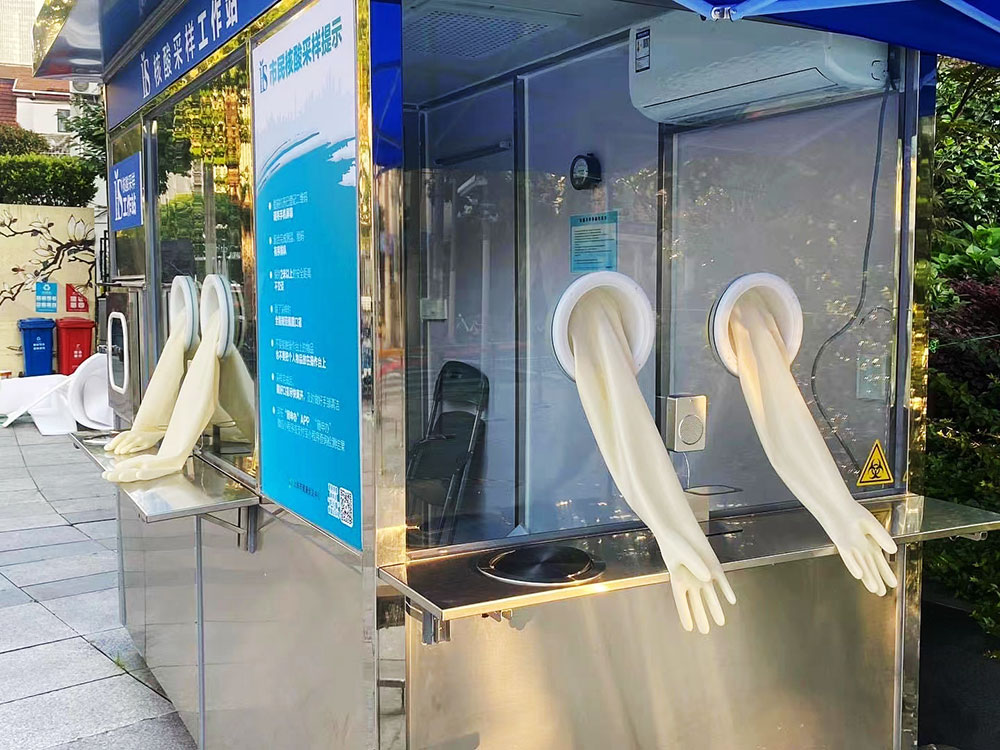
Fig. 6: One of the 9000 PCR test booths installed after the lockdown. (Photo by the author, 2022)
The informal sector is especially in danger of disappearing from the city. Wet markets became a target – since the first COVID-19 case was linked to a wet market in Wuhan – and are frequently bulldozered. Although there are exemptions and modern redesigned markets. Also, many informal traditional neighborhoods are undergoing major overhauls. This resulted from an official statement that the number of infections was particularly high in the original old town in the Huangpu district. Most of the old town is listed for drastic regeneration, which means demolition and rebuilding, usually for a different target group – mainly higher incomes – and adding to the existing shortage of affordable housing. This old town area is now mainly inhabited by low-skilled migrant workers, often subletters with no or temporary work contracts, crammed into too small spaces full of bunk beds and poorly shared sanitary facilities. Meanwhile, private homeowners who rent out these spaces usually live in newly built neighborhoods and wait for the moment that their old property is expropriated, which generates large sums of money for them. For local authorities, the post-pandemic situation created an opportunity to accelerate this urban regeneration process, according to a tried-and-true process of eviction-demolition-construction. During the lockdown most extreme roadblocks were around this part of the city, including my previous neighborhood (a traditional lilong unit).
While globalization has helped cities grow in importance worldwide, and urban governments often act more decisively than national governments, during the lockdown the control in Shanghai was taken over by the central government in the aftermath. In the public opinion, the local (and actually later also the national) government has failed in its approach. During the lockdown sarcastic jokes circulated on social media that the fictitious “Shanghai yen” is worth only a quarter of the Chinese yen, suggesting that many of the wealthy will seek refuge (and investment) elsewhere. Attracting foreign investors and companies will be a lot more difficult, partly fueled by international tensions, resulting in many vacant buildings. 6 After two decades of openness, lightning-fast economic growth, and international opening up, there is a threat of a turn towards a new closedness. Another cynical joke circulating on social media during the lockdown was a manipulated video of Leonardo DiCaprio on the prow of the Titanic, turning around and hugging a masked moped courier who comes to deliver a meal. The cynical double message of this video is clear: food is the absolute top priority, and the socio-economic consequences of the lockdown brought this city full of glitter and glamor to the brink of collapse.
Yet, today, a year later, the city is recovering slowly. Those who didn’t leave are still having a hard time, mentally and in terms of social security. Working hours increased to catch up with economic losses, it is even common now to work more than 6 days a week and skip holidays. Nevertheless, the city begins to bustle steadily and will undoubtfully reinvent itself, although with a lot of uncertainty. 7
Harry den Hartog is an urban designer and researcher, who founded his own research & design studio Urban Language in 2004 (https://urbanlanguage.org). Since 2012, he has been a faculty member at Tongji University’s College of Architecture and Urban Planning in Shanghai. He also has a research position at Delft University in the Netherlands. His research focus is on (Chinese) new town developments, waterfront transformations, and urban-rural relations. ORCID: https://orcid.org/0000-0003-1033-5739. Email: harry.den.hartog@urbanlanguage.org